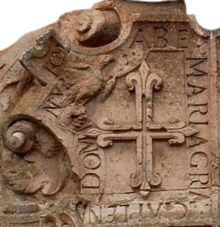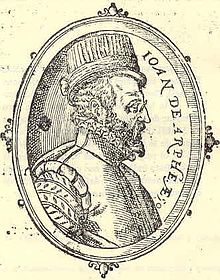José Velázquez de Medrano
José Velázquez de Medrano | |
|---|---|
| Born | 1561 |
| Died | 1622 |
| Occupation | Silversmith |
José Velázquez de Medrano[1] (1561–1622) was a Navarrese noble and artist from the House of Medrano in Logroño and the most significant silversmith of his time during the Spanish Golden Age.[2][3]
Background

Don José Velázquez de Medrano was born in Logroño, La Rioja.[4] He belongs to the illustrious and influential House of Medrano.[5] Don José Velázquez de Medrano has been credited as being one of the best examples of Spanish silversmith's craft at the end of the 16th century and the beginning of the 17th century.[6]
Marriage
Originally from Logroño, José Velázquez de Medrano married the daughter of Don Felipe de Guevara.[6]
Apprenticeship
Don José Velázquez de Medrano completed his apprenticeship in the home of his father-in-law, who had practiced his craft in Castile and Aragon before settling in Navarre and opening a workshop in Pamplona, as stated in his own declaration from 1571.[7] However, there has been no verifiable evidence of Felipe de Guevara's presence in Aragon, despite documentation of other silversmiths with the same surname.[6]
Medrano's silversmith workshop in Arga
Don José Velázquez de Medrano continued in Guevara's workshop until the latter's death in 1588. Subsequently, he completed some of Guevara's unfinished projects, often overshadowing Guevara's son, Hernando, who was also a silversmith. This situation reportedly caused tensions, prompting Velázquez de Medrano to establish his own workshop for gold and silversmithing. Medrano quickly gained a reputation as the leading silversmith in the city of Arga and expanded his influence into the regions of Aragon, leaving behind some of his most noteworthy works.[6]
It's likely that the Guevara family facilitated José Velázquez de Medrano's introduction to the Aragonese episcopal circles during a period when the local silver workshops, prominent throughout the century, were in decline.
Attorney
In a related note from 31 December 1594, Margarita Marcuello appointed José Velázquez de Medrano as her attorney. Documented as residing in Pamplona and currently in Tarazona, he was responsible for managing the inheritance of her brother, the silversmith Juan Díez Marcuello, who had recently passed away in the capital of Navarre.[8]
Artistic Contributions
The master silversmith Don José Velázquez de Medrano's significant works primarily include a series of stationary monstrances and Eucharistic pavilions. These pieces, created between 1594 and 1608, reflect the heightened importance of Eucharistic worship in the Spanish Church post-Trent Council. His craftsmanship is particularly noted in several major works. Jose's work has been described by historians as a synthesis between the classicist aesthetic driven by El Escorial, assimilated from the treatise by Juan de Arphe y Villafañe, and the practice more concerned with highlighting the plastic values of the architecture typical of Romanist altarpieces, which had a distinguished creative center in Navarre.[4]

All of Medrano's works are distinguished by their high technical quality, showcasing both intelligent and detailed architectural design as well as comprehensive iconographic schemes related to the Eucharist. José Velázquez de Medrano's works are distinguished by their technical quality and architectural design, which includes extensive iconographic programs. His ability to combine practical craftsmanship with theoretical knowledge allowed him to achieve significant standing among his contemporaries. According to historians, these qualities elevate José Velázquez de Medrano to the ranks of the finest "sculptors of silver and gold" who were shaped by Juan de Arphe y Villafañe (b. 1535, active 1564–1603). Solid proof of Medrano's proficiency in drawing is demonstrated by Bishop Antonio Zapata y Mendoza (1596–1600), who commissioned him to design the main altarpiece for the Pamplona Cathedral in 1597, contrary to the previously suggested year of 1598.[6]
Don José Velázquez de Medrano's influence extended beyond Navarre to Aragon, where his works were commissioned and appreciated. His ability to adapt his training and theoretical knowledge into practical and revered ecclesiastical art cemented his legacy as the most significant figure in Spanish silversmithing during his time.[2]
While many of Medrano's creations are no longer extant, it is documented that he crafted the parish crosses for Santa María de Tafalla, Mendavia, Falces, Iroz, Lerruz, and Iragui, none of which have survived.[4]
Preserved works
Some of Medrano's preserved works include the chrismatories of Arróniz, completed before 1610, and two of the four plain chalices he produced for Artajona around the same time, both bearing marks, in addition to the base and several enhancements to the monstrance of Santa María de Sangüesa in 1598, as well as the reliefs on the processional platform of the Pamplona Cathedral. Also included are the beautiful chrismatories of Arróniz (Navarre), a chalice from Eguarás (Navarre), and a ciborium from Ardáiz (Navarre), a work not documented but likely attributed to him.[9]
Monstrances and pavilions

Don José Velázquez de Medrano's prestige is largely attributed to his remarkable collection of stationary monstrances and Eucharistic pavilions, referred to as "andas" by Juan de Arfe y Villafañe in his "de varia commensvracion..." because they were used in processions, created during the central part of his career, between the years 1594 and 1608.[6] These creations were a major part of his work from 1594 to 1608. The most notable pieces include the pavilions for La Seo de Tarazona (1594–1597) and the monstrances for the Huesca Cathedral (1596–1601)[10] and San Pablo parish in Zaragoza (1604–1606),[2] all of which were made for locations in Aragon. In contrast, the pavilion for the Pamplona Cathedral (around 1597–1598)[11] was his only commission from Navarre,[12] however the one from the Aula Dei Charterhouse (1606–1608)—have disappeared.[6]

The period between 1595 and 1600 was pivotal in his career, signing his most significant commissions by hand. Between 1595 and 1597, he constructed the Eucharistic pavilion of the Tarazona Cathedral, financed by the Villalón family.[13]
The agreement for the Huesca Cathedral monstrance (1594) granted two and a half years to complete the project, leading to its delivery in April 1601. The involvement of notable patrons such as the Villalón family, who funded part of the works, and the chapter members of various cathedrals who managed and oversaw the completion and quality assurance of his creations. The Villalón family contributed 2,000 escudos (40,000 sueldos) to the cost of the monstrance for the Huesca Cathedral.[2]
Chrismatories and chalices
Don José Velázquez de Medrano's craftsmanship significantly influenced areas of Navarre, particularly in Olite and Estella. Noteworthy are the widespread distribution of chrismatories like those from Arróniz. The chalices from Artajona is especially notable as they uniquely feature the silversmith's personal signature, which includes his full surname in capital letters across two lines, a rare characteristic in his body of work.[4]
List of works by José Velázquez de Medrano
- Platforms of La Seo de Tarazona, created 1594–1597
- Monstrance of the Huesca Cathedral, created 1596–1601. Initially commissioned in 1594, with a formal contract signed on June 21, 1596. The work was delivered in April 1601, weighing 2,016 ounces and valued at 3,812 escudos.
- Monstrance of the parish of San Pablo in Zaragoza, created 1604–1606
- Eucharistic Pavilion of the Pamplona Cathedral, created 1597–1598
- Monstrance of the Charterhouse of Aula Dei, created 1606–1608
- Processional Cross of Cirauqui Exact date of its creation is not specified, but it is attributed to him after his father-in-law's death
- Chrismatories of Arróniz, created in 1610
- Chalices from Eguarás and Artajona
- Ciborium from Ardáiz
Bibliography
- R. del Arco y Garay: Documentos inéditos sobre la custodia y la sillería de coro de la catedral de Huesca, Huesca, 1912. Catálogo Monumental de España: Huesca, Madrid, 1942, p. 185.
- J. Altadill: Artistas navarros exhumados. José Velázquez de Medrano, platero de Pamplona, C.M.N., 1914, pp. 79-85, 205-209.
- T. Biurrun Sotil: La escultura religiosa y Bellas Artes en Navarra durante la época del Renacimiento, Pamplona, 1935, pp. 451-454.
- L. Hernández Ascunce: El templete del Corpus del cardenal Zapata, Diario de Navarra, 9.VI.1955.
- M.C. García Gaínza, M.C. Heredia Moreno: La orfebrería de la catedral y del museo Diocesano de Pamplona, Pamplona, 1978, pp. 59-63.
- M.C. Heredia Moreno: El templete eucarístico de la catedral del Tarazona, Seminario de Arte Aragonés, 1981, pp. 22-28.
- M.C. García Gaínza, M.C. Heredia Moreno, J. Rivas Carmona, M. Orbe Sivatte: Catálogo Monumental de Navarra II. Merindad de Estella, Estella, 1982. Catálogo Monumental de Navarra… Olite, Pamplona, 1985, pp. 14, 277, 468, 470.
- M.C. García Gaínza: El mecenazgo artístico del obispo Zapata en la catedral de Pamplona, Scripta theológica, 1984, pp. 579-588.
- C. Hernmarchk: Custodias procesionales en España, 1987, p. 210.
- M.C. Heredia Moreno, M. Orbe Sivatte: Orfebrería de Navarra I. Edad Media, Pamplona, 1986, n.° 23. Orfebrería de Navarra II. Renacimiento, Pamplona, 1988, nos 3, 27, 34.
References
- ^ "Medrano, José Velázquez de - Auñamendi Eusko Entziklopedia". aunamendi.eusko-ikaskuntza.eus (in Spanish). Retrieved June 2, 2024.
- ^ a b c d Mainar, Jesús Criado (December 1, 2001). "Nuevas noticias sobre la producción aragonesa del platero José Velásquez de Medrano. 1594-1608". Artigrama (in Spanish) (16): 351–385. doi:10.26754/ojs_artigrama/artigrama.2001168433. ISSN 2444-3751.
- ^ Mainar, Jesús Criado (December 1, 2001). "Nuevas noticias sobre la producción aragonesa del platero José Velásquez de Medrano. 1594-1608". Artigrama (in Spanish) (16): 351–385. doi:10.26754/ojs_artigrama/artigrama.2001168433. ISSN 2444-3751.
- ^ a b c d "Gran Enciclopedia de Navarra | VELÁZQUEZ DE MEDRANO, JOSÉ". Retrieved June 2, 2024.
- ^ "MEDRANO - Auñamendi Eusko Entziklopedia". aunamendi.eusko-ikaskuntza.eus. Retrieved June 2, 2024.
- ^ a b c d e f g Criado Mainar, Jesús Fermín (2001). "Nuevas noticias sobre la producción aragonesa del platero José Velázquez de Medrano. 1594-1608". Artigrama: Revista del Departamento de Historia del Arte de la Universidad de Zaragoza (16): 351–386. ISSN 0213-1498.
- ^ A. de Orbe y Sivatte and Mª C. Heredia Moreno, Biografía de los plateros navarros, ob. cit., p. 138.
- ^ Juan Sornoza, a silversmith in the service of Velázquez de Medrano, appears as a witness (A.H.P.T., Pedro Pérez de Álaba, 1595, ff. 10-11) in Tarazona on December 31, 1594.
- ^ A. de Orbe y Sivatte and Mª C. Heredia Moreno, Biografía de los plateros navarros del siglo XVI. Aproximación a su entorno, Pamplona: Gobierno de Navarra, 1998, pp. 281-29., Ibidem, pp. 291-294.
- ^ Lizano, Fernando Alvira (November 5, 2015). "Huesca, Catedral, custodia procesional". Patrimonio de Huesca (in European Spanish). Retrieved June 2, 2024.
- ^ Altadill y Torrontera de Sancho San Román, Julio (1914). "Artistas navarros exhumados. José Velázquez de Medrano, platero de Pamplona". Boletín de la Comisión de Monumentos Históricos y Artísticos de Navarra (in Spanish): 205–209.
- ^ "El platero Velázquez de Medrano y la microarquitectura en plata". Cátedra de Patrimonio y Arte Navarro (in European Spanish). Retrieved June 2, 2024.
- ^ Archivo Municipal de Tudela, Sección de Protocolos [A.M.Td.], Domingo Royo, notary of Cascante, 1597, folios 187-189.
